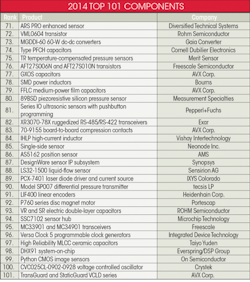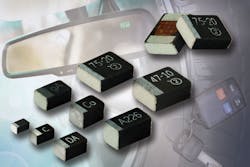What’s a component? Isn’t it anything we design into an electronic product? That’s a perennial discussion topic whenever we compile our annual list of the Top 101 Components (see the table). So, here’s an attempt at an answer. A component is anything we use that isn’t memory or a device that executes a program from memory.
It’s a resistor, a discrete semiconductor device, a switch, a transient suppression device, or a battery. It doesn’t have to be a linear device. For example, if it’s a voltage regulator, it can be a switcher or a low-dropout regulator (LDO). It can even be the box you put your design inside, if it’s a standard product you would buy from a distributor.
Top Of The List
So, what product rose to the top of this year’s survey? (see “Readers Pick The Top 101 Components”) It’s a box with a particular variety of mounting arrangements: DIN rails. “DIN” is the acronym for “Deutsches Institut für Normung,” the standards body that developed the EN (European Norm) 50022 standard for mounting circuit breakers on electrical panels. Apparently, DIN has been widely adopted for rack-mounting small assemblies in industrial control systems.
A series of DIN rail-mount enclosures from Automation Systems Interconnect has taken the number-one slot (Fig. 1). These enclosures come in 12.5-, 17.5-, 22.5-, 35-, 45-, and 67.5-mm wide housings. Ventilating slots ensure cooler, stable internal temperatures and reduce overheating issues. Snap-in covers enclose the opening of any unused connector slots. The cover can be cut to accept various connector interfaces and LEDs.
If that seems like a strange product to lead the list, consider how many Electronic Design readers are engaged in industrial control, the design of which is generally customized to each implementation. If the enclosures are as versatile as they seem, and they can be hung on any convenient EN50022 DIN rail in an equipment rack, this is a great solution.
What’s Hot?
Take a look at number three on the list, the Brain Sentry Impact Sensor from STMicroelectronics (Fig. 2). Mounted on sports helmets, the omnidirectional microelectromechanical-systems (MEMS) accelerometer accurately measures accelerations produced by collisions, regardless of the direction of the contact. The light (1 oz) and compact device also taps a unique battery-life management system that lets it be active for a full year without recharging.
It’s no wonder why the Brain Sentry Impact Sensor attracted a lot of attention. It’s also not surprising that the next component on the list is another accelerometer. The ADXL375 three-axis digital MEMS accelerometer from Analog Devices will find homes in low- and high-powered wireless sensor networks employed in concussion detection, transportation, asset tracking, and other applications .
Already, the ADXL375 has been designed into the newest generation of the Blast Gauge body-worn blast detection system from BlackBox Biometrics. In addition to its low power drain, implying long intervals between charging, its integrated memory-management system consists of a 32-level first-in first-out (FIFO) memory. Its low-power modes can be used to set impact thresholds, store data, and reduce overall power consumption by offloading those functions from the host processor.
This file type includes high resolution graphics and schematics when applicable.
Odd Or Intriguing
Taking the sixth spot on our list, the ARL capacitive touch switch from CIT Relay & Switch offers embedded capacitive touch slider functionality that can be linear or rotary (Fig. 3). The haptic feedback device’s options include a pushbutton function and a timer for time-demand programs. Applications include audio and video equipment, automotive, lighting, instrumentation, and appliances.
Do you need to measure how much aerated liquid is in a tank? The liquid’s fizziness may make that a tricky proposition. Positioned at number 21, the LL-01 Sentio series miniature ultrasonic liquid-level switches from Measurement Specialities operate when the liquid reaches their level, but no mechanical parts are involved (Fig. 4).
The sensing for these single-pole, single-throw (SPST) normally open switches is ultrasonic. They also can stand ambient pressures up to 250 psig. Versions rated for pressures up to 500 psig are available, as are normally closed versions. They run on 5 to 30 V dc as well.
Ranked at number 24, the Texas Instruments bq27421 lithium-ion (Li-ion) battery fuel gauge targets portable medical devices such as wearable health monitors and industrial devices like inventory scanners (Fig. 5). It uses TI’s impedance track advanced battery technology, which is quite a bit more sophisticated than simple fuel-gauge ICs that simply count coulombs going in and subtract coulombs out. Instead, it provides more information about remaining battery capacity, state of charge, and battery voltage, extending the run-time of portable devices. The new and improved Gauge Studio software tool is available as well.
Passives Draw Attention
Can there be anything new to say about resistors, capacitors, and coils? Can novel passives attract reader attention? There were 10 capacitors on the list, six inductors, and one lone resistor, which appeared at number 34. Vishay Precision Group’s FRFC 0805 high-precision, next-generation, surface-mount, Bulk Metal Z1-Foil technology device is all about precision and long-term stability (Fig. 6).
The resistor offers load-life stability of ±0.005% (50 ppm) at 70°C and rated power for 2000 hours. Its typical temperature coefficient of resistance (TCR) is ±0.005/°C from 0°C to 60°C and ±0.2 ppm/°C from –55°C to 125°C. Power TCR is 5 ppm at rated power, and tolerances run tight to ±0.01%. It’s also small, even for a surface-mount passive. Its flip-chip configuration saves up to 35% of board space compared to surface-mount resistors with wraparound terminations. Resistances of 5 Ω to 8 kΩ are available.
The 10 capacitors on the list ranged from the twentieth slot down to number 97. The top draw, Vishay Intertechnology’s TP8 molded, automotive-grade, solid-tantalum chip capacitor series, is the first AEC-Q200-qualified lineup to deliver high capacitance-voltage ratings in 0603, 0805, and 0906 case sizes, according to the company (Fig. 7).
Despite the smaller packaging, capacitance and voltage ratings still run from 1.0 µF at 40 V to 100 µF at 0.3 V. The devices offer standard capacitance tolerances of ±10% and ±20% and an operating temperature range of –55°C to 85°C, or 125°C with voltage derating. The caps are intended for energy storage, filtering, and decoupling in space-constrained automotive applications including tire pressure monitoring systems, camera modules, rearview mirrors, and remote keyless entry.
The six inductors among the Top 101 Components ranged from 39 to 84. Ranked at 39, TDK’s MLP1005M1R0D multilayer power inductors come in a 1.0- by 0.5- by 0.7-mm IEC 1005 case, the smallest available, for a shrink of approximately 60% (Fig. 8). Rated inductance and current are 1.0 µH and 500 mA. A new, low-loss ferrite material allows such high currents for their size. Applications include smartphones, tablets, digital cameras, and other mobile devices.
Number 84 in overall reader interest was a high-temperature-rated automotive inductor from Vishay. The Vishay Dale IHLP-2525CZ-8A high-current inductor can operate from –55°C to 180°C (Fig. 9). It comes in a 3.0-mm high 2525 case and can be ordered in inductance values from 0.47 to 22 µH.
Typical dc resistance ranges from 3.87 to 163.0 mΩ. The guaranteed maximum range is from 4.14 to 173.0 mΩ. Also, the inductor will handle frequencies up to 1 MHz. Target applications include engine and transmission control units, diesel injection drivers, entertainment and navigation systems, noise suppression for motors, windshield wipers, and high-intensity discharge (HID) and LED lighting.
Sensors Rule
Sensors constitute the largest category on our list, with 32 items. For example, ON Semiconductor’s Python CMOS image sensor family offers 0.3-, 0.5-, and 1.3-Mpixel resolutions. Ranked 99th on our list, these devices enable in-pixel correlated double sampling (ipCDS), which delivers CCD-like (charge-coupled device) optical performance from a CMOS imaging device (Fig. 10).
Few industrial-control applications rely only on one or two sensors. Ranked at number 94, Microchip’s SSC7102 sensor hub can “fuse” data produced by multiple motion sensors such as accelerometers, magnetometers, and MEMS gyroscopes, plus environmental sensors for properties such as light intensity, temperature, humidity, and atmospheric pressure (Fig. 11). It consumes approximately 4 mA while running complex sensor-fusion algorithms, extending battery life for Windows 8.1 tablets, laptops, ultrabooks, and smartphones.














